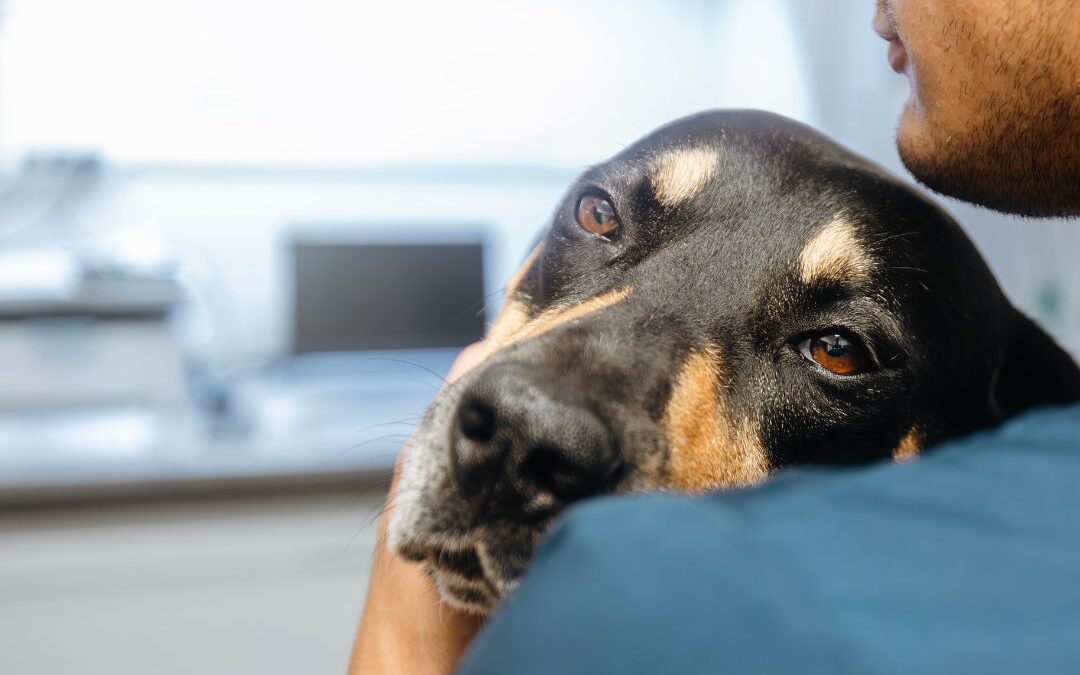Canine parvovirus (CPV) is a highly contagious, often deadly viral disease that targets the gastrointestinal tract and immune system of dogs—especially puppies. It spreads through infected feces and contaminated surfaces like grass, soil, shoes, kennels, bowls, and hands. The virus can survive in the environment for months. Certain breeds—including Rottweilers, Dobermans, American Pit Bull Terriers, and German Shepherds—may be at higher risk, but any unvaccinated or under-vaccinated dog is vulnerable.
Parvo attacks rapidly dividing cells in the intestinal lining, stripping away the protective barrier of the gut. Dogs develop severe vomiting and foul-smelling, often bloody diarrhea. They quickly become dehydrated and develop dangerous electrolyte imbalances. Many are profoundly lethargic, stop eating, and may run a fever—or, in severe cases, their temperature drops. The virus also attacks bone marrow at the same time the virus drives down white blood cell counts, leaving patients defenseless against life-threatening bacterial infections and sepsis. Without aggressive treatment, many puppies die within 48 to 72 hours of severe symptoms.
We frequently see parvo cases in pets that received “feed-store” or internet vaccines. These products may be improperly stored, administered at the wrong intervals, or simply ineffective against circulating strains. By contrast, veterinary-administered vaccines are handled under strict cold-chain protocols, given at the correct ages and intervals, and recorded for medical continuity. That difference can be the line between life and death.
The vaccine plan that saves lives starts early and must be finished. Puppies should begin vaccinations at 6 to 8 weeks of age and receive boosters every 3 to 4 weeks until at least 16 weeks old; many need a dose at 16 to 18 weeks to overcome maternal antibody interference. Adolescents and adults with unknown status need two doses, 3 to 4 weeks apart. A booster is due one year after the puppy series and then typically every three years, per current AAHA guidelines or as your veterinarian advises.
Until the puppy series is complete, exposure control matters. Avoid dog parks, pet stores, public puppy classes, sidewalks with heavy dog traffic, and contact with unknown dogs. Carry young puppies outdoors to a treated, controlled area. Do not let them sniff floors or grass where other dogs eliminate. If you have or suspect you’ve had parvo in your home, disinfection starts immediately. Parvo is resistant to most cleaners! I’ve heard it said that parvo laughs at most cleaners. After cleaning, use a fresh 1:30–1:32 dilution of regular household bleach on hard, colorfast surfaces, allowing a full 10 minutes of contact time. Soak bowls and toys in a bucket. For porous surfaces and yards, prevention is best—this virus can persist for months to years. I once saw five generations of puppies get parvo in one household. I don’t know if they cleaned up or got tired of me telling them that they needed to clean and disinfect.
Know the early warning signs and act fast. Repeated vomiting, diarrhea (especially if bloody), profound lethargy, not eating, or a puppy that “just isn’t right” all warrant immediate veterinary care. Time matters; early treatment significantly improves survival. Parvo hits like a ton of bricks.
Treatment requires intensive, often hospital-based care. We correct dehydration and electrolyte losses with IV fluids, control vomiting with antiemetics, protect the GI tract, provide pain relief, and administer broad-spectrum antibiotics to counter secondary bacterial invasion and sepsis. Patients need glucose monitoring, nutritional support, and strict isolation to prevent spread. Advanced options can include anti-parvoviral monoclonal antibody when available, plasma or colloid support, and round-the-clock nursing care. With prompt, appropriate hospital care, 80–90% of patients can survive. Selected cases may manage with structured outpatient protocols, but survival is more variable. Without treatment, mortality is high.
The cost realities are hard but important to discuss. Parvo care is intensive and expensive, driven by isolation requirements, supplies, and nursing time. Consider pet insurance while your pet is healthy or maintain an emergency fund or credit line. Some of the hardest conversations we have happen when cost limits care for a disease we could have prevented.
There is a community dimension to parvo as well. Every unvaccinated dog increases environmental contamination and risk to others. Responsible breeding and seller practices matter: puppies should receive age-appropriate veterinary vaccines and a documented health exam before sale. Buyers should insist on veterinary records—not just a handwritten “shot given” note.
The bottom line is straightforward. Vaccinate on schedule with your veterinarian—start at 6 to 8 weeks, boost every 3 to 4 weeks until at least 16 weeks, and booster at one year. Avoid high-risk environments until the series is complete. Call immediately at the first sign of vomiting, diarrhea, or lethargy. Over-the-counter vaccines provide a dangerous false sense of security.
If you have questions about parvovirus prevention, vaccination timing, or safe socialization for your puppy, contact your veterinarian.

